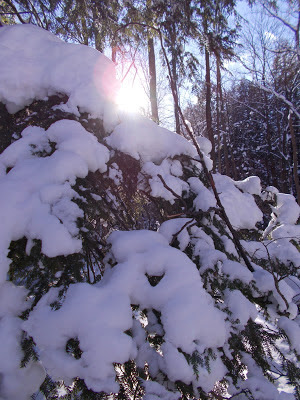This was the view in the Park today.
The gorgeous snow of just days ago has fallen to high temperatures and torrential rains. This morning the rains came through the area like walls of water. One could follow them coming and wondered how much harder could the rain possibly fall? Now there is the mixture of warm air and cool snow on the ground. This cloud runs the length of the stream as far as I could see.
Remember I mentioned the wintry silence of the Park last week? Now the creek is shouting at the world as its water run the roller-coaster ride downstream to Presque Isle Bay, then Lake Erie. This photo of stormwater runoff rushing down our swale shows perfectly how important plants and vegetation are to help manage extra water and snow melt. If this trail were paved, everything would be washed directly into Mill Creek. With the plants on the trail and slope, all the extra water is being slowed down and filtered and absorbed by surrounding plants. This natural process helps keep Mill Creek a lot cleaner.
Normally the picture to the left would be all grass and plants. The 'waterway' in the middle is actually a grassy trail. But when part of the park is in a floodplain, events like this snowmelt/rainstorm change everything.
I would have walked deeper, but didn't think to bring hip waders. It was knee deep and I didn't even make it close to the middle of the photo above.
The Black Willow above is adapted to wet ground and having 'wet feet', or letting their roots grow in wetter soil. On a dry day, the above photo is all woodland, dry logs and twigs, and completely accessible. If you have not read the previous post about the Mill Creek Flood of 1915, check it out. It's not hard to imagine that August night, after viewing these photos. The power of water.





















